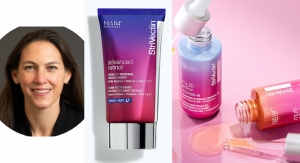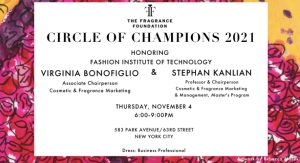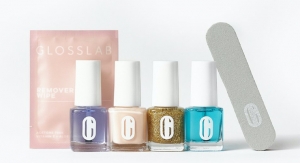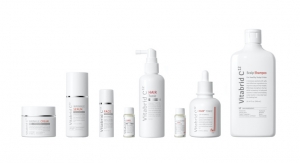Nancy Jeffries09.17.15
Margaret Hayes, president, The Fashion Group International (FGI), introduced two doyennes of the fashion and beauty industries at a Tastemakers event, held at the 21 Club in New York City.
Hayes introduced Rose Marie Bravo, former president of Saks Fifth Avenue, and vice chairman and former CEO of Burberry, and Pamela Baxter, president, Dior, as two women with a most successful career history. Both executives shared their experiences in beauty and fashion, while Bravo served as interviewer.
The three are shown in the photo above, left-right: Pamela Baxter, Margaret Hayes, and Rose Marie Bravo at FGI’s Tastemakers Event
Hayes, who acknowledged the event sponsors, LVMH, Dior, and Arcade Beauty for making the Tastemaker’s presentation possible, said that she had worked with Bravo many years prior, and noted her storied accomplishments, among them as CEO of

Pamela Baxter, president, Dior, at FGI’s Tastemakers
event, held July 15, at the 21 Club in New York City
Burberry, and an appointment as a Commander of the British Empire.
Baxter, she said, had held positions at The Lauder Companies, where she was responsible for such brands as Prescriptives and Crème de la Mer. Baxter is now president and CEO of LVMH Perfumes and Cosmetics for Christian Dior, and also oversees couture for North America and Mexico, as well as the Dior brand.
Among notable guests in attendance were Linda Fargo, sr. VP, Bergdorf Goodman, Annette Green, former president, The Fragrance Foundation, and Hervé Bichon, president, North America, Arcade Beauty.
A Journey From a South Dakota Ranch
Bravo queried Baxter’s earliest influences and the experiences that drove her professional path, inquiring, “From a ranch in South Dakota to Paris, France and New York, what influences were most important along the way?”
Baxter, whose father was a rancher in Mobridge, South Dakota, recalled that from an early age she knew she had a “passion for fashion.” She said, “I worked on the ranch to earn money for clothes, and at the age of 12, when I was reading an issue of Vogue, I spotted a pair of Galo shoes and ordered them, C.O.D.”
She recalled how her father had her work on the ranch to pay for those shoes. But there, in that small town of 5,000 people, is where her passion began, and where she learned an important lesson from her family, “Your integrity and your reputation are your most prized possessions.”
She sold the car her mother had given her after college and headed for her first job in New York City, at Charles of the Ritz, where she became a makeup artist and later a trainer. “The cosmetics training was excellent. The beauty business is intense and covers everything involved in fashion. You’ve got ‘clientelling,’ where you learn to get the customers to keep coming back, merchandising, and retail and development,” said Baxter.
She noted similarities between the fashion and beauty industries, and acknowledged the role of the beauty advisor and merchandising in both areas. Reflecting on her experience with Jo Malone and Prescriptives, during her tenure at The Lauder Companies, she said, “If I was going to stay in beauty, I was super happy at The Lauder Companies.”
Baxter, however, wanted to transition to a fashion brand and recalled Leonard Lauder’s understanding of her decision when she was leaving his employ. “Young lady, you have no idea what you’re getting into. You will need someone to watch your back. You can take one person with you when you leave,” Baxter recalled. She selected Terry Darland, then VP of Prescriptives.
“Fashion didn’t believe that beauty had relatable skills,” noted Baxter. When she interviewed with Dior and listened to Bernard Arnault’s vision for the Dior brand, she realized the brand was disconnected from the fashion side of the business at that time, and believed she could meld her beauty experience with the brand. She came in on the beauty side in 2004 and in 2007 “got the keys to the fashion kingdom,” having successfully bridged what some believed was a gap between beauty and fashion.
Unique Brand DNA
Bravo noted the differences between working for a French company and working for an American company. “The French are very analytical. They like to debate and they place a great emphasis on education. They don’t make decisions quickly. The American entrepreneurial spirit is different. They take more risks,” said Bravo. Working for Dior and living in France, Baxter had to adapt to a different way of doing business.

Rose Marie Bravo with Annette Green, former president, The Fragrance
Foundation, at The Tastemakers event.
Bravo said Baxter’s experience with brand building was key in developing the Dior relationship and asked what Baxter thought of the notion of continuous reinvention.
“If you take the Dior brand and look at the advertising for beauty and fashion, you can see they were not on the same page. The fashion brand was licensing everything from sheets to towels. Beauty and fashion were not speaking to each other. There were about 500 licenses diluting the brand, which Arnault stopped, as this was confusing customers,” said Baxter.
She described how Dior went to logo-ed handbags and then decided to return to the history and heritage of the brand.
“Now we’re taking it back to where the house was originally. Know what your brand DNA is,” she said. She credits Raf Simons for turning the Dior house around after Galliano’s departure, and acknowledged the heart he has shown for the brand. Bravo noted the importance of a robust brand DNA, adding, “We need the creative juice that stays connected to the brand DNA, but still moves forward,” she said.
When asked what it takes and how long it takes for a brand to develop, Bravo noted that it could be three years before you get a taste of what it’s going to be like, then an additional five to see its growth, and another five to fifteen years to see the breadth of a brand. “Now, with the Internet, it’s changed. The enabler of digital has sped everything up, but making the right decisions and filling the need are still paramount,” said Bravo. Baxter cited Fresh as an example of a brand that came into its own. “Fresh, for example, took 25 years to arrive at its current position. We re-engineered it into skin care and it’s a good fit. Brands also have to be global, so that’s something to keep in mind,” offered Baxter.
“In 1995, when Lauder bought La Mer, it took four years to formulate around what was basically a jar of cream. But if the DNA is strong enough, it will grow. People are still telling the story of Max Huber, the scientist who was burned in a lab, and how the marine-based ingredients combined in the right formula, helped heal his burns, and ultimately became La Mer,” said Baxter. Clearly, a brand with a resonant story remains vital.
When asked by an audience member how Baxter, who is a grandmother, juggled her work and personal life, Baxter replied, “I just did it. I didn’t think about it. You just figure it out. Mothers are always more organized because they have to be.”
Hayes introduced Rose Marie Bravo, former president of Saks Fifth Avenue, and vice chairman and former CEO of Burberry, and Pamela Baxter, president, Dior, as two women with a most successful career history. Both executives shared their experiences in beauty and fashion, while Bravo served as interviewer.
The three are shown in the photo above, left-right: Pamela Baxter, Margaret Hayes, and Rose Marie Bravo at FGI’s Tastemakers Event
Hayes, who acknowledged the event sponsors, LVMH, Dior, and Arcade Beauty for making the Tastemaker’s presentation possible, said that she had worked with Bravo many years prior, and noted her storied accomplishments, among them as CEO of
Pamela Baxter, president, Dior, at FGI’s Tastemakers
event, held July 15, at the 21 Club in New York City
Baxter, she said, had held positions at The Lauder Companies, where she was responsible for such brands as Prescriptives and Crème de la Mer. Baxter is now president and CEO of LVMH Perfumes and Cosmetics for Christian Dior, and also oversees couture for North America and Mexico, as well as the Dior brand.
Among notable guests in attendance were Linda Fargo, sr. VP, Bergdorf Goodman, Annette Green, former president, The Fragrance Foundation, and Hervé Bichon, president, North America, Arcade Beauty.
A Journey From a South Dakota Ranch
Bravo queried Baxter’s earliest influences and the experiences that drove her professional path, inquiring, “From a ranch in South Dakota to Paris, France and New York, what influences were most important along the way?”
Baxter, whose father was a rancher in Mobridge, South Dakota, recalled that from an early age she knew she had a “passion for fashion.” She said, “I worked on the ranch to earn money for clothes, and at the age of 12, when I was reading an issue of Vogue, I spotted a pair of Galo shoes and ordered them, C.O.D.”
She recalled how her father had her work on the ranch to pay for those shoes. But there, in that small town of 5,000 people, is where her passion began, and where she learned an important lesson from her family, “Your integrity and your reputation are your most prized possessions.”
She sold the car her mother had given her after college and headed for her first job in New York City, at Charles of the Ritz, where she became a makeup artist and later a trainer. “The cosmetics training was excellent. The beauty business is intense and covers everything involved in fashion. You’ve got ‘clientelling,’ where you learn to get the customers to keep coming back, merchandising, and retail and development,” said Baxter.
She noted similarities between the fashion and beauty industries, and acknowledged the role of the beauty advisor and merchandising in both areas. Reflecting on her experience with Jo Malone and Prescriptives, during her tenure at The Lauder Companies, she said, “If I was going to stay in beauty, I was super happy at The Lauder Companies.”
Baxter, however, wanted to transition to a fashion brand and recalled Leonard Lauder’s understanding of her decision when she was leaving his employ. “Young lady, you have no idea what you’re getting into. You will need someone to watch your back. You can take one person with you when you leave,” Baxter recalled. She selected Terry Darland, then VP of Prescriptives.
“Fashion didn’t believe that beauty had relatable skills,” noted Baxter. When she interviewed with Dior and listened to Bernard Arnault’s vision for the Dior brand, she realized the brand was disconnected from the fashion side of the business at that time, and believed she could meld her beauty experience with the brand. She came in on the beauty side in 2004 and in 2007 “got the keys to the fashion kingdom,” having successfully bridged what some believed was a gap between beauty and fashion.
Unique Brand DNA
Bravo noted the differences between working for a French company and working for an American company. “The French are very analytical. They like to debate and they place a great emphasis on education. They don’t make decisions quickly. The American entrepreneurial spirit is different. They take more risks,” said Bravo. Working for Dior and living in France, Baxter had to adapt to a different way of doing business.
Rose Marie Bravo with Annette Green, former president, The Fragrance
Foundation, at The Tastemakers event.
“If you take the Dior brand and look at the advertising for beauty and fashion, you can see they were not on the same page. The fashion brand was licensing everything from sheets to towels. Beauty and fashion were not speaking to each other. There were about 500 licenses diluting the brand, which Arnault stopped, as this was confusing customers,” said Baxter.
She described how Dior went to logo-ed handbags and then decided to return to the history and heritage of the brand.
“Now we’re taking it back to where the house was originally. Know what your brand DNA is,” she said. She credits Raf Simons for turning the Dior house around after Galliano’s departure, and acknowledged the heart he has shown for the brand. Bravo noted the importance of a robust brand DNA, adding, “We need the creative juice that stays connected to the brand DNA, but still moves forward,” she said.
When asked what it takes and how long it takes for a brand to develop, Bravo noted that it could be three years before you get a taste of what it’s going to be like, then an additional five to see its growth, and another five to fifteen years to see the breadth of a brand. “Now, with the Internet, it’s changed. The enabler of digital has sped everything up, but making the right decisions and filling the need are still paramount,” said Bravo. Baxter cited Fresh as an example of a brand that came into its own. “Fresh, for example, took 25 years to arrive at its current position. We re-engineered it into skin care and it’s a good fit. Brands also have to be global, so that’s something to keep in mind,” offered Baxter.
“In 1995, when Lauder bought La Mer, it took four years to formulate around what was basically a jar of cream. But if the DNA is strong enough, it will grow. People are still telling the story of Max Huber, the scientist who was burned in a lab, and how the marine-based ingredients combined in the right formula, helped heal his burns, and ultimately became La Mer,” said Baxter. Clearly, a brand with a resonant story remains vital.
When asked by an audience member how Baxter, who is a grandmother, juggled her work and personal life, Baxter replied, “I just did it. I didn’t think about it. You just figure it out. Mothers are always more organized because they have to be.”



























